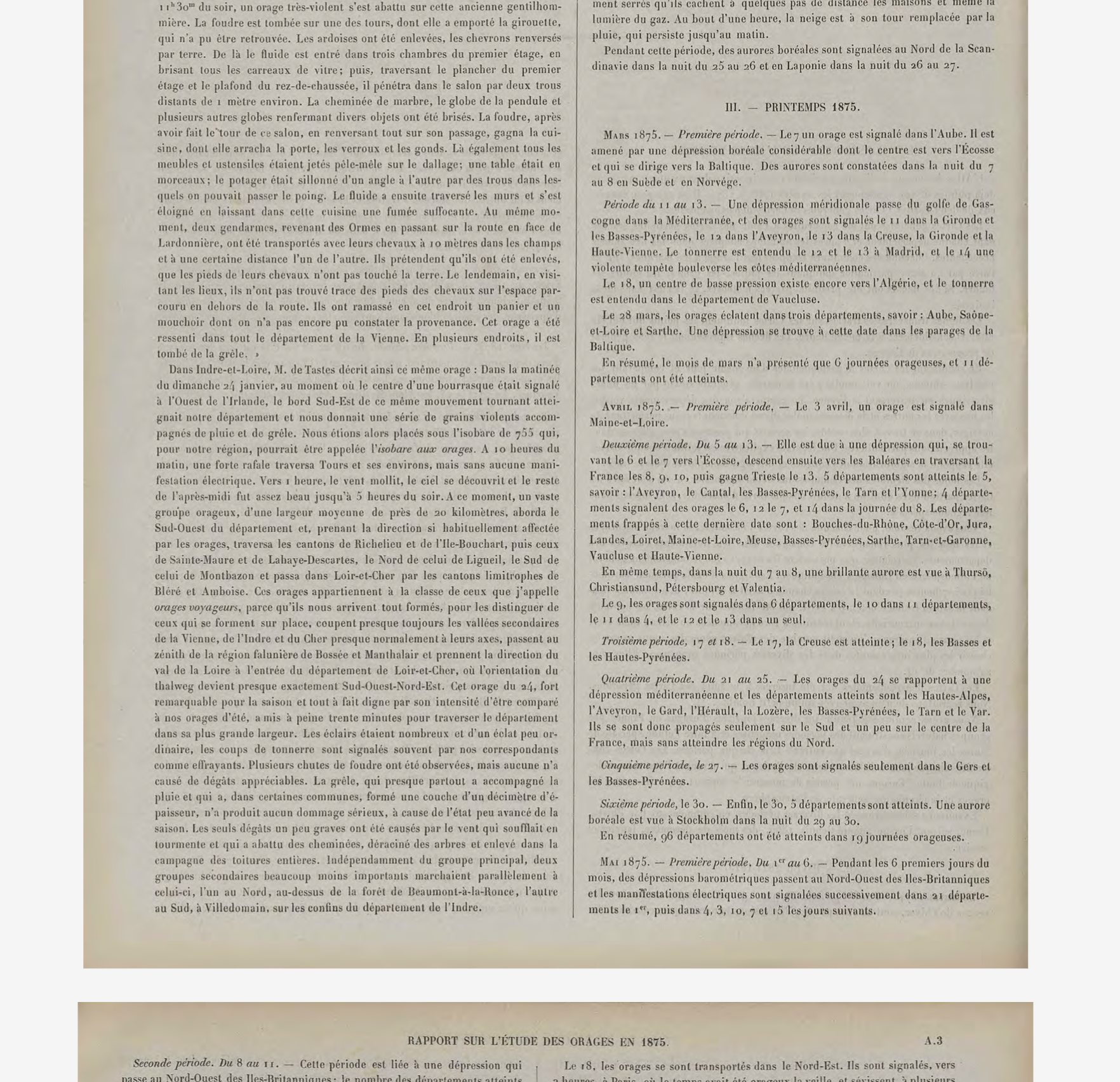What was the weather in Paris on the day the Treaty of the Meter was signed? And why do I need to know?
•
The Treaty of the Meter was signed in Paris on May 20, 1875. The document established an international bureau of weights and measures, and established international measurement standards for length and mass: the meter and the kilogram.
I have noticed that documentary films will often include a bird's-eye view of maps, and surround the edges of the maps with clouds. Pretty! I had an impulse to add clouds around the edges of my stop-motion bird's-eye view of a map of France in the 1780s, in the sequence about the Treaty of the Meter.
But wait! Was it truly cloudy on that day? Could I find out?
The answer comes from two experts use two different methods, and confirm each other's conclusions.
Expert 1: Reconstructed estimates of past weather
Dr. Laura Slivinski explains how she estimates the weather: "The 20th Century Reanalysis Project Version 3 reconstructs the weather over the whole world, every 3 hours, from 1836-2015. This dataset was created using a modern weather forecast model with predefined sea surface temperature and sea ice, and combining those model guesses with actual observations of surface pressure from land stations and ships." Dr. Slivinski is part of the Cooperative Institute for Research in Environmental Sciences and the [ NOAA Physical Sciences Laboratory in Boulder, Colorado.
"Our estimate of the weather, therefore, is not based on any documentary data or any observations of weather except for surface pressure. We do not use observations of temperature, rain, or wind, for instance.
"Below I'm showing 2m air temperature, cloud cover, and precipitation at 12Z on May 20 1875. The plots suggest that it was about 15C, somewhat cloudy (about 30% cloud cover), and not raining much if at all, at noon on May 20 1875. We can also look at 0Z, 6Z, or 18Z, or other variables."
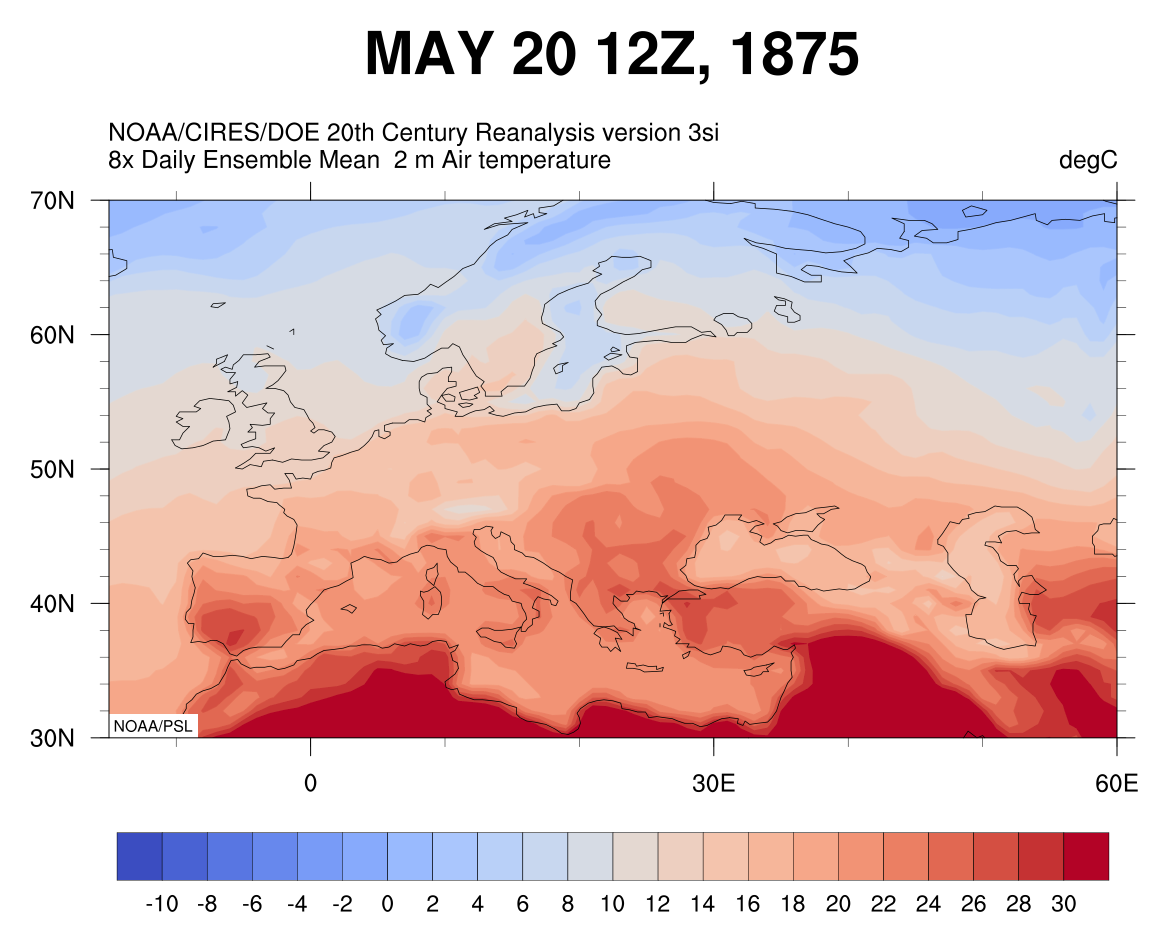
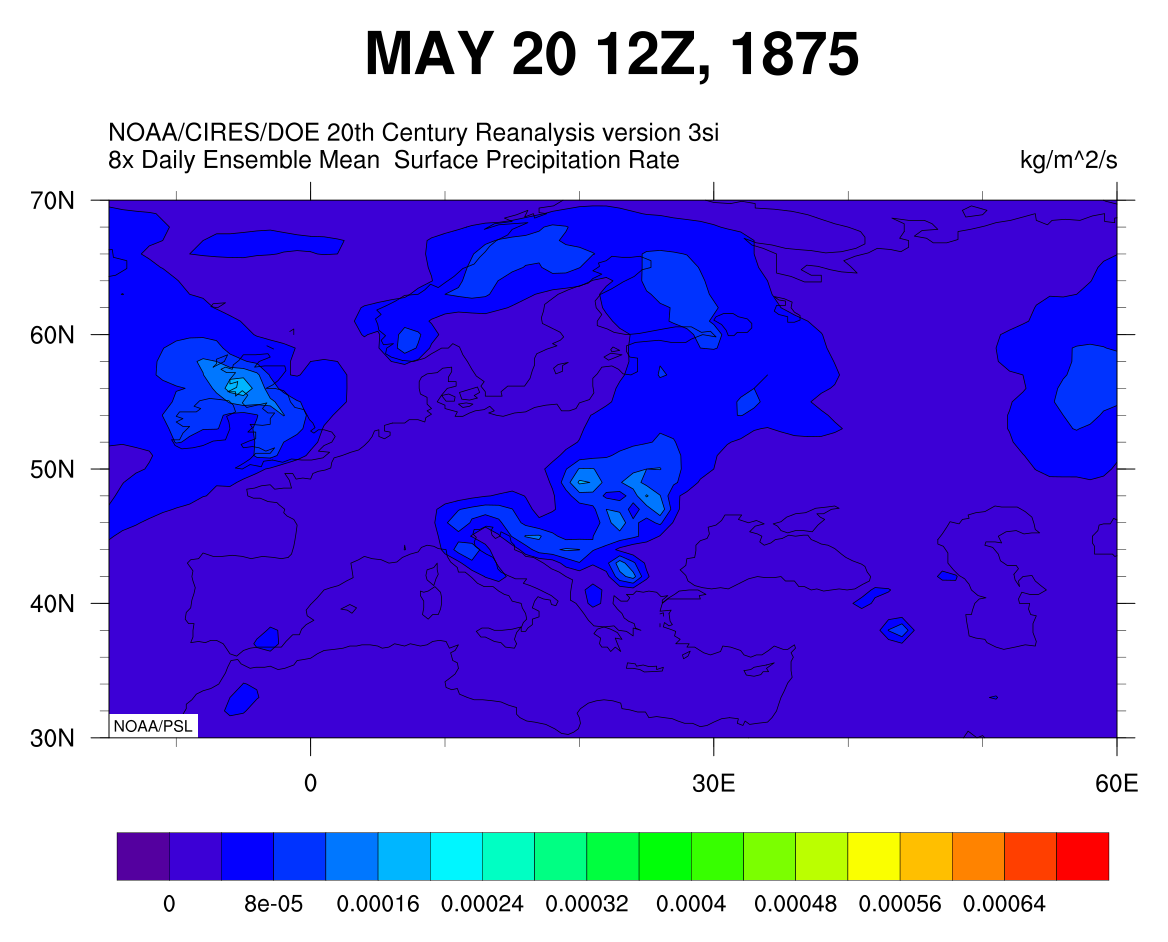
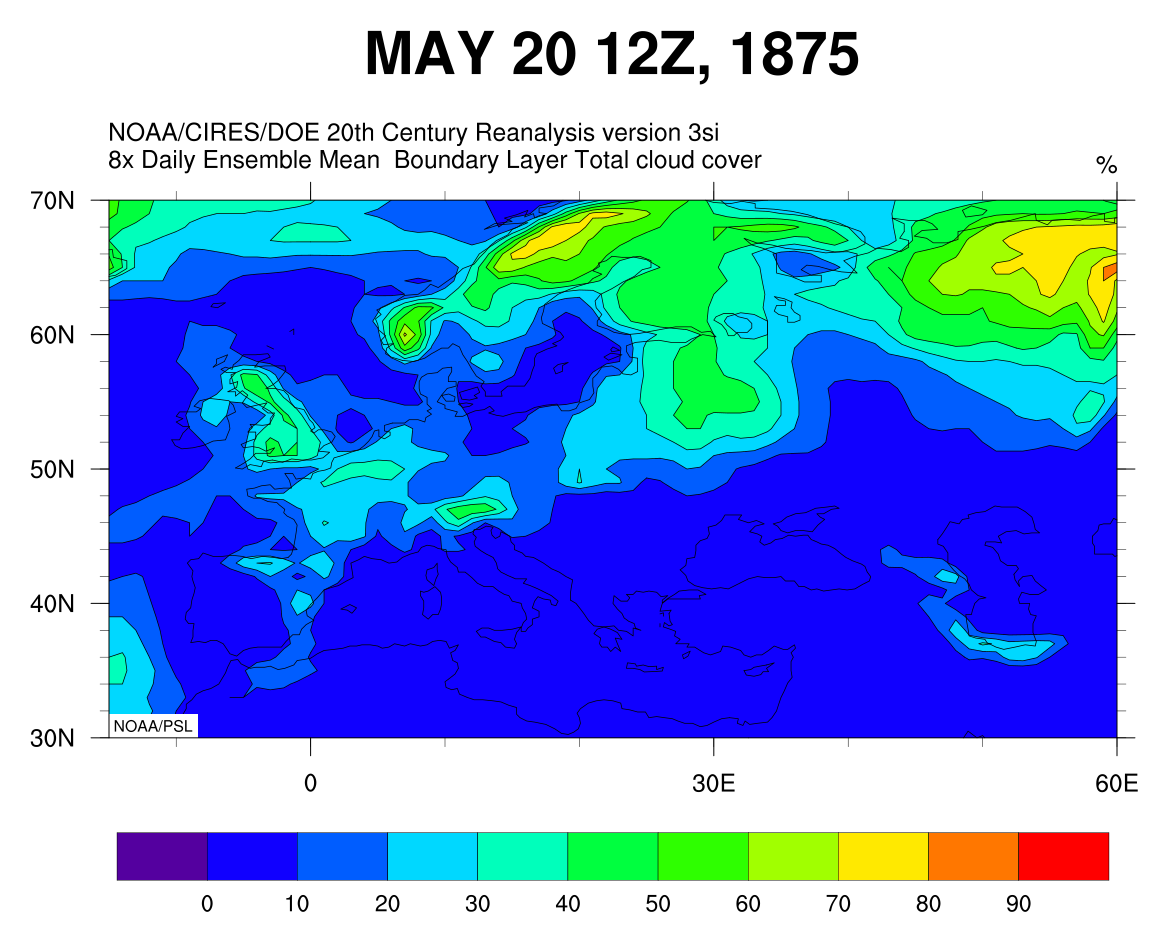
I wasn't familiar with Z time, which is for meteorology measurements. 18Z is noon, and 12Z is 6am.
Dr. Slivinski suggests, "For a precise account of the weather in a specific city on a specific day, you may want to investigate documentary sources."
Which brings us to the second expert.
Expert 2: Documentary sources of historic weather data
Documentary sources for this location and time period are illuminated by Professor Daniel Rousseau, the "father of modern French Numerical Weather Prediction"[2] who has reconstructed a series of temperatures in Paris from 1676 to 2008 (La Météorologie, 8th series, 67, 2009, 43-55).
In correspondence with Kilofilm's science advisor Michael Trott, Professor Rousseau references the recorded min-max temperatures in Paris on May 20th, 1875:
- 3.7°C and 21.1°C in Paris Montsouris and
- • 5.5°C and 19.3°C at the Saint-Maur observatory, very close to Paris.
Note that the Treaty of the Meter was signed at the Ministry of Foreign Affairs at 37 Quai d'Orsay, near Place de la Concorde. https://fr.wikipedia.org/wiki/H%C3%B4tel_du_ministre_des_Affaires_%C3%A9trang%C3%A8res The Treaty is now stored at the archives of the Ministry, located a 3 rue Suzanne Masson, La Courneuve, about 25 minutes away by car.
Professor Rousseau then explains how he interprets the temperatures: "I do not have the observations of cloudiness and rain available in my archives, but given the large difference between the maximum temperature and the minimum temperature, it is likely that it did not rain and that on May 20 (as well as the 21st for that matter) has been a beautiful sunny day (see attached Excel file [5]).
"This is confirmed by examining the Meteorological Atlas of the year 1875 published by the Paris Observatory available on the Internet 'DOC-METEO: Le portail documentaire de Météo-France'.
http://bibliotheque.meteo.fr/exl-php/vue/mf_-_internet_bibliotheque_numerique_-_fonds_ancien
Professor Rousseau continues, "Of which I am attaching an extract, which indicates that in May 1875 there were thunderstorms on May 17 and 18 in Paris, which followed a sequence of high temperature reaching more than 27°C on May 16 as indicated in the attached Excel file."
Experts agree: It was a mild and sunny day.
Thus independent experts agree, using two different approachs. This situation reminds me of the way that the silicon sphere experiment and the watt balance experiments converged on a value for Planck constant, prior to redefinition of the kilogram.
As for Kilofilm, if I want to be accurate, there should be few (if any) clouds in my stop-motion sequence of May 20, 1875.
References and Sources and Notes
- Support for the Twentieth Century Reanalysis Project version 3 dataset is provided by the U.S. Department of Energy, Office of Science Biological and Environmental Research (BER), by the National Oceanic and Atmospheric Administration Climate Program Office, and by the NOAA Physical Sciences Laboratory.
- Atlas Météorologique. Année 1875. "Report of the Study of Storms in 1875" Professor Rousseau's excerpt begins at the bottom right of page A.2. http://bibliotheque.meteo.fr/exl-php/docs/mf_-_internet_bibliotheque_numerique_-_fonds_ancien/234967/doc00024429__PDF.txt He highlights in red the text beginning, "On the 18th, the thunderstorms transported in the Northeast. They are reported, around 2 o'clock, in Paris, where the weather had been stormy..."
- Daniel Rousseau. Les températures mensuelles en région parisienne de 1676 à 2008. La Météorologie, 67, 43-55, 2009. doi: https://lameteorologie.fr/issues/2009/67/meteo_2009_67_43
- Daniel Rousseau. Excel file of Recorded Temperatures for May 1875 in two Locations in and near Paris France.
- Anders Persson. "Early operational Numerical Weather Prediction outside the USA: an historical introduction: Part II: Twenty countries around the world." Meteorology Applications 12, 269–289 (2005) doi:10.1017/S1350482705001751. On page 275: "Only in the mid-1960s did civil servants again begin to retire and make room for young scientists. The first one to enter was a man who was to become the leader of the modern generation of French dynamical meteorologists: Daniel Rousseau." Then Section 4.5 is titled "The father of modern French NWP [Numerical Weather Prediction]". When Daniel Rousseau joined Metéorologie Nationale in 1963 he was in fact the first young scientist to join after a very long period." https://rmets.onlinelibrary.wiley.com/doi/pdf/10.1017/S1350482705001751
To follow Professor Rousseau's trail of documents:
- Start at the DOC-METEO website: http://bibliotheque.meteo.fr/exl-php/vue/mf_-_internet_bibliotheque_numerique_-_fonds_ancien
-
Click on "Atlas météorologiques. Observatoire de Paris"
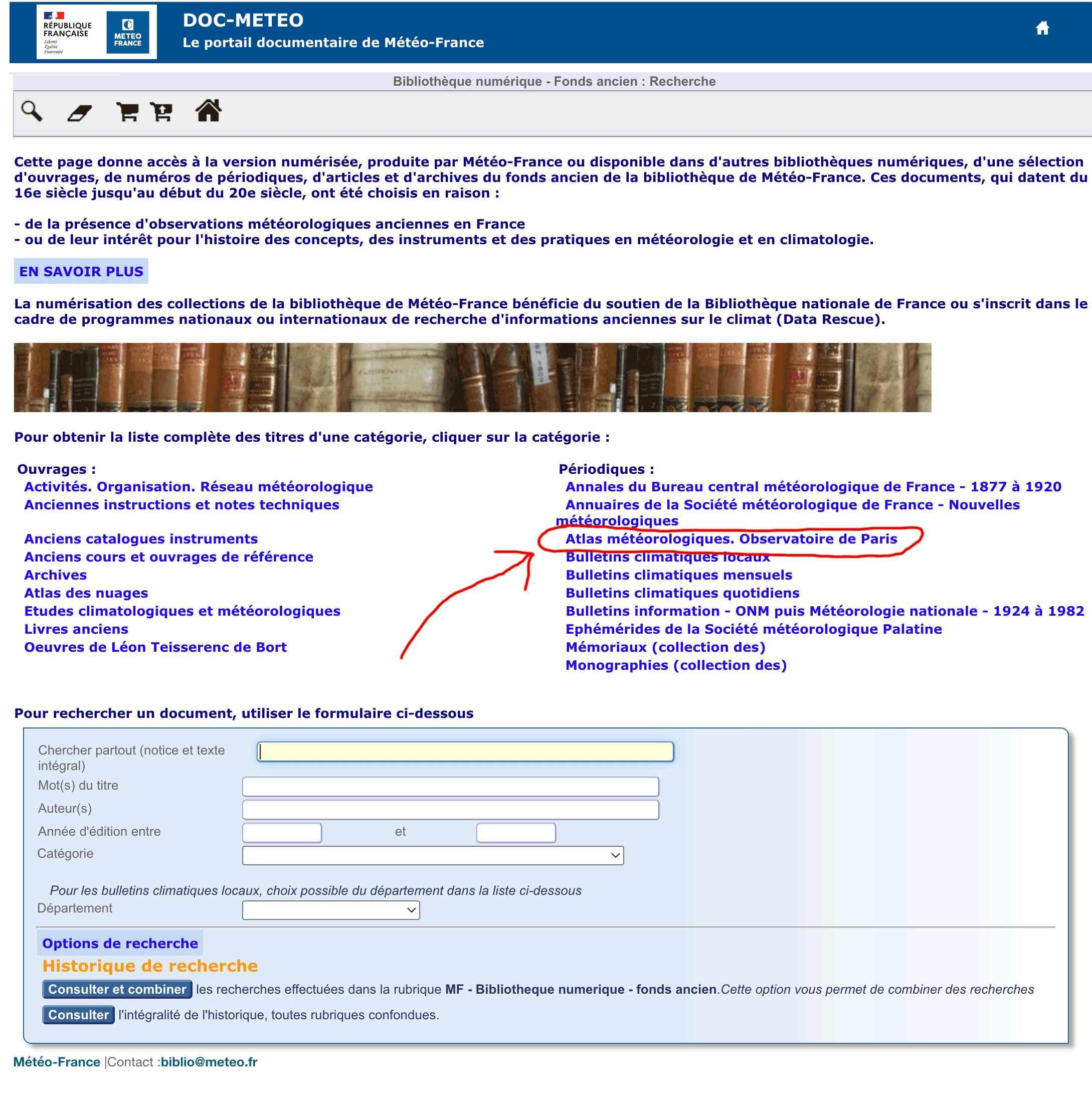
- You will get a list of Atlases, from a gigantic URL http://bibliotheque.meteo.fr/ query is very long...
-
The atlas which Professor Rousseau references is "Atlas météorologique de l'Observatoire de Paris, année 1875 ([tome VII]). [1ère partie, Orages + Grêles] Année d'édition: 1877." His excerpt starts at the bottom of page A.2. The direct link is :
http://bibliotheque.meteo.fr/exl-php/docs/....
